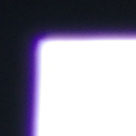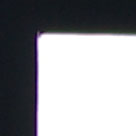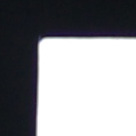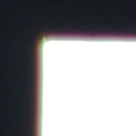Pentax DA 40mm and 70mm Limited lens review, tested with Pentax K10D
-
-
Written by Gordon Laing
Quality
The DA 70mm f2.4 Limited is also supplied with a screw-on metal lens hood, and while much larger than the previous model, is still very small. It’s a push-pull design which measures 16mm in length when retracted, or 24mm when extended. You’ll probably leave it fitted for most of the time as the classy velvet-lined lens cap is designed to slip over the hood and not the bare lens itself. Like the 40mm Limited, the filter thread measures 49mm. Both lenses are also supplied with carrying pouches. While both lenses are small and light, they have superb build quality with all-metal construction, featuring high-grade aluminium barrels, hoods and caps. The focusing rings are also very smooth in operation, complete with distance markings on both, and additional depth-of-field guides on the 70mm; the 40mm barrel simply isn’t long enough to squeeze them on. Both lenses are quite audible when focusing on the K10D, and as mentioned earlier your fingers may get a small surprise as the focusing rings turn during autofocus. While the end section of each lenses also extends during focusing, they at least don’t rotate which will come as some relief to users of polarising filters. The DA 40mm f2.8 Limited lens focuses faster, additionally improved by a shorter angular range from infinity to its closest focusing distance of 40cm. The DA 70mm f2.5 Limited feels noticeably slower when focusing, and must turn almost twice the angle from infinity to its closest focusing distance of 70cm. |
Pictured below from left to right are the Pentax DA 40mm f2.8, the DA 70mm f2.4 (shown twice with its supplied lens hood retracted and extended), and the DA 18-55mm f3.5-5.6 kit lens. Even with the kit lens adjusted to its 35mm focal length where the barrel is at its shortest, you can see straightaway how much smaller the pair of Limited Edition lenses are.
Measuring 63mm wide and just 15mm long (when focused at infinity), the Pentax DA 40mm f2.8 Limited is one of the smallest standard DSLR lenses in the world. Weighing 90g without its supplied lens hood, it’s also very light. Mount this on any Pentax DSLR and you’ll hardly even notice it; indeed it’s barely larger than a DSLR body cap. It’s easy to understand how it’s nicknamed a ‘pancake’ lens.
The Pentax DA 70mm f2.4 Limited lens is clearly larger than the 40mm, but still highly compact at 63mm wide and 26mm long (when focused at infinity). It weighs 130g without the supplied lens hood. We’ve pictured it above with its lens hood attached and in its retracted and extended positions – see below for details.
Both lenses are so short, there’s very little to hold onto, and you’re also likely to brush your fingers against the focusing ring when it turns during autofocus. But there is a slim ridge right by the mounts you can safely grip and both lenses are so light they need little ‘under-barrel’ support anyway. The K10D body also has a ridge on its left side which acts as a small grip for your left hand – see our Pentax K10D review.
Both lenses are supplied with lens hoods, but neither are the common petal designs. The DA 40mm f2.8 Limited has a very slim metal screw-on lens hood which adds just 7mm to the total length and could easily be mistaken for a lens cap. The lens cap itself is actually a smaller diameter metal disc which screws into the hood. The filter thread into which the hood also screws, measures 49mm in diameter.
Pentax DA 40 and 70mm Limited lens coverage with Pentax K10D
The Pentax DA 40mm f2.8 and 70mm f2.4 Limited lenses have effective focal lengths of 60 and 105mm respectively when mounted on a Pentax DSLR. This gives them almost standard and short telephoto coverage respectively.
To illustrate their coverage in practice, we shot the same scene with each lens within a few moments of each other from a tripod to ensure a consistent position. To show how their coverage compares to the standard kit lens, we’ve also included samples from the DA 18-55mm f3.5-5.6. So below from left to right are the Pentax DA 18-55mm at 18mm, followed by the DA 40mm f2.8 Limited, the DA 18-55mm zoomed-into 55mm and finally the DA 70mm f2.4.
Pentax DA 18-55mm at 18mm |
Pentax DA 40mm f2.8 |
Pentax DA 18-55mm at 55mm |
Pentax DA 70mm f2.4 | |||
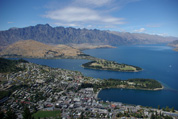 |
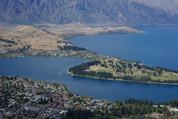 |
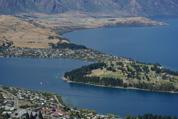 |
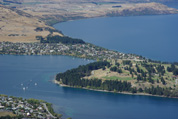 | |||
18-55mm at 18mm (27mm equiv) |
40mm (60mm equiv) |
18-55mm at 55mm (83mm equiv) |
70mm (105mm equiv) |
The samples above have no surprises: the DA 40mm f2.8 Limited delivers roughly the same coverage as mid-way through the kit lens range, while the DA 70mm f2.4 Limited is slightly more powerful. The DA 40mm is just a little longer than a standard lens in practice, while the DA 70mm offers short telephoto capabilities. See our Gallery page for portrait and landscape samples.
Pentax DA 40 and 70mm Limited lens aperture
The DA 40 and 70mm Limited lenses have maximum focal ratios of f2.8 and f2.4 respectively. Both provide a bright view when composing, decent flexibility in low light and the potential to create very small depth-of-fields. The DA 70mm is particularly good in this regard and makes an ideal portraiture lens – see our Gallery for examples.
Pentax Shake Reduction with the K10D and DA 70mm Limited
The DA 40 and 70mm Limited lenses don’t feature optical stabilisation, but mount them on either the K10D or K100D bodies and their built-in Shake Reduction systems will extend the range of shutter speeds you’ll safely be able to handhold. For a full report on how the Pentax Shake Reduction system works, see our Pentax K10D review, but in the meantime, here’s an excerpt with examples taken using the DA 70mm lens.
In use we found the K10D’s Shake Reduction system certainly allowed us to handhold longer exposures than normal, but we rarely achieved more than two stops of compensation. During numerous tests, the biggest difference between an image taken with and without Shake Reduction can be seen below. Both images were taken moments apart using the K10D fitted with the DA 70mm Limited Edition lens, thereby working at an effective focal length of 105mm.
With the aperture closed to f22 at 100 ISO, the shutter speed was 1/8 of a second. We cropped an area from each image measuring 564×272 pixels, then reduced it to 282×136 pixels for reproduction here; you’re therefore viewing the images at 50%.
Pentax DA 70mm with K10D Shake Reduction OFF |
Pentax DA 70mm wit K10D Shake Reduction ON | |
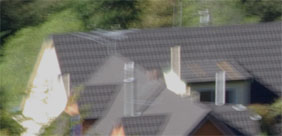 |
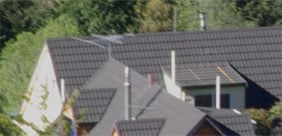 | |
70mm (105mm equiv), 1/8, f22, 100 ISO |
70mm (105mm equiv), 1/8, f22, 100 ISO |
The image above right with Shake Reduction enabled may not be 100% sharp (even when viewed at 50%), but it does show a great improvement over the image above left. When we increased the shutter speed to the point where both images were 100% sharp though, there were only two stops difference. Like all anti-shake systems though, the effectiveness varies between people and situations. The bottom line is the K10D’s Shake Reduction system certainly made a difference, but not as much as experienced with other image stabilisation systems.
Outdoor scene – Pentax DA 40mm vs DA 18-55mm vs DA 70mm lenses with Pentax K10D
Pentax DA 40mm f2.8 Limited Using Pentax K10D |
Pentax DA 18-55mm at 55mm Using Pentax K10D |
Pentax DA 70mm f2.4 Limited Using Pentax K10D | ||
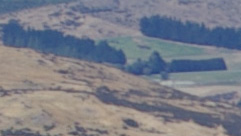 |
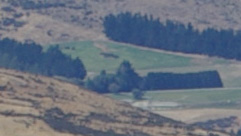 |
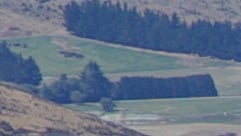 | ||
1/350, f8, 100 ISO |
1/350, f8, 100 ISO |
1/350, f8, 100 ISO | ||
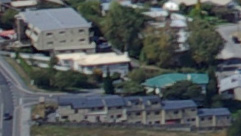 |
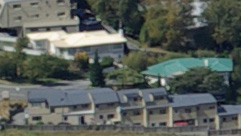 |
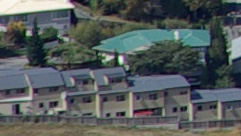 | ||
1/350, f8, 100 ISO |
1/350, f8, 100 ISO |
1/350, f8, 100 ISO | ||
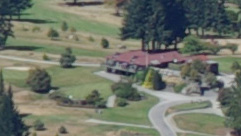 |
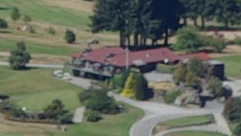 |
 | ||
1/350, f8, 100 ISO |
1/350, f8, 100 ISO |
1/350, f8, 100 ISO |
| As explained above, the different lens focal lengths have captured progressively smaller fields of view, and hence the detail in each can’t be directly compared. The crops do however show how each lens handles similar subject matter while revealing certain optical characteristics. Of the three lenses above, the 70mm Limited appears to be the sharpest, a result also shared in our Gallery pages; it’s a great choice for anyone who wants an extremely compact, high quality, short telephoto lens for a Pentax DSLR. We should note our sample of the 40mm Limited lens in our tests was slightly soft in the centre when focused at infinity. |
Pentax DA 40 and 70mm lens results continued…
Outdoor / Resolution / Corner sharpness / Fringe and macro / Geometry / Vignetting
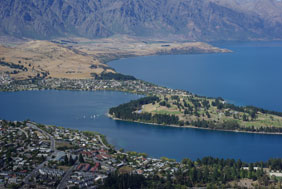 |
To compare real-life performance we shot the same scene with the Pentax 40mm, 18-55mm and 70mm lenses within moments of each other using a Pentax K10D in Aperture Priority mode. The 18-55mm was zoomed to 55mm for this test and all lens apertures set to f8.
Clearly the three lenses tested here have different focal lengths and therefore different fields of view. As such the actual crops can’t be directly compared in terms of detail, but they do give an indication of how each handles the same subject matter.
The image left was taken with the Pentax K10D using the DA 40mm Limited Edition lens at f8; the original JPEG measured 3.29MB. The crops below are presented here at 100%.
Pentax DA 40 and 70mm lens resolution comparison with Pentax K10D
Pentax DA 40 and 70mm lens results continued…

Outdoor / Resolution / Corner sharpness / Fringe and macro / Geometry / Vignetting
To measure resolving power we photographed the Enhanced Digital Camera Resolution Chart with each lens set to f8 using a Pentax K10D in Aperture Priority mode. Each lens was tested at a variety of apertures and f8 selected as the sharpest. The K10D was set to its best quality JPEG 10M *** mode. The crops are taken from the original images, saved as High Quality JPEGs in Photoshop CS2 and presented here at 100%. Each number represents 100 lines per picture height (lpph), so a figure of 20 means a resolution of 2000 lpph. |
Using the DA 18-55mm kit lens at 35mm f8, the K10D delivered 2050 and 2150 lpph of horizontal and vertical resolution respectively. When fitted with the better quality Pentax DA 40 and 70mm Limited Edition lenses, the K10D delivered measurably superior figures of 2200 lpph for both horizontal and vertical resolution on both lenses. There’s very little to call between the two Limited Edition lenses in this test, and both can bring the best out of the K10D, allowing it to compare favourably with the best of the current crop of 10 Megapixel DSLRs. Note: we’ve taken these measurements at the point where moiré began to blur the lines, but the extinction resolution for the K10D in this test was actually much finer. |
Pentax DA 18-55mm f3.5-5.6 AL Using Pentax K10D |
Pentax DA 40mm f2.8 Limited Using Pentax K10D | |
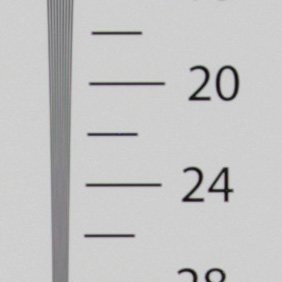 | 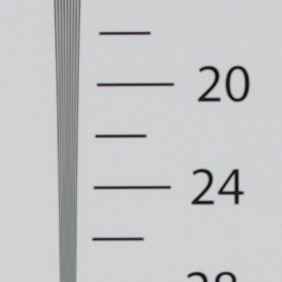 | |
2050 lpph, DA 18-55mm at 35mm, f8, 100 ISO |
2200 lpph, DA 40mm at f8, 100 ISO | |
Pentax DA 70mm f2.4 Limited Using Pentax K10D |
Nikkor DX 18-70mm Using Nikon D80 | |
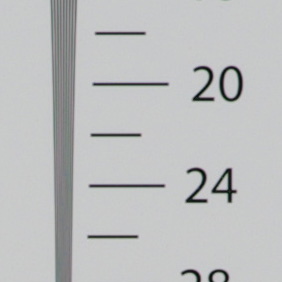 | 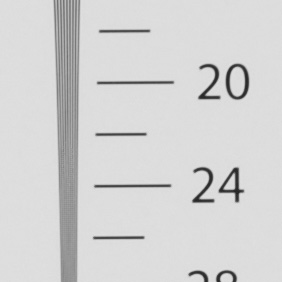 | |
2200 lpph, DA 70mm at f8, 100 ISO |
2200 lpph, DX 18-70mm at 35mm, f8, 100 ISO |
Pentax DA 18-55mm f3.5-5.6 AL Using Pentax K10D |
Pentax DA 40mm f2.8 Limited Using Pentax K10D | |
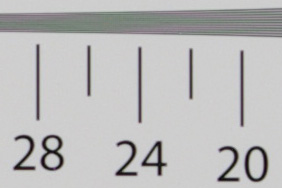 | 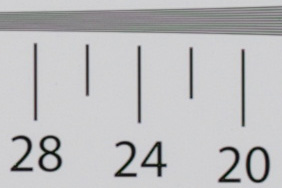 | |
2150 lpph, DA 18-55mm at 35mm, f8, 100 ISO |
2200 lpph, DA 40mm at f8, 100 ISO | |
Pentax DA 70mm f2.4 Limited Using Pentax K10D |
Nikkor DX 18-70mm Using Nikon D80 | |
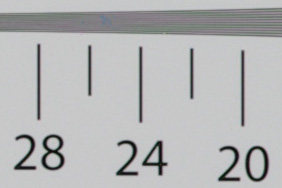 | 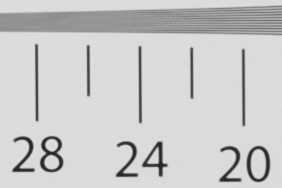 | |
2200 lpph, DA 70mm at f8, 100 ISO |
2200 lpph, DX 18-70mm at 35mm, f8, 100 ISO |
Pentax DA 40 and 70mm lens corner sharpness, tested with Pentax K10D
Pentax DA 40 and 70mm lens results continued…

Outdoor / Resolution / Corner sharpness / Fringe and macro / Geometry / Vignetting
|
To measure corner sharpness we photographed the Enhanced Digital Camera Resolution Chart with each lens using a Pentax K10D. The K10D was set to its best quality JPEG 10M *** mode. Each lens was tested with various apertures selected in Aperture Priority mode; the DA 18-55mm was tested at both 18 and 55mm focal lengths. The crops are taken from the lower left corner of the chart and presented here at 100%. |
| In these tests of a chart photographed at fairly close range, neither the Pentax 40 nor 70mm lenses can be described as pin-sharp in the corners at wider apertures, but they’re both much more impressive than the DA 18-55mm kit lens at 18mm – and their f2.8 and f2.4 maximum apertures are brighter than the f3.5 of the kit lens. The fairer comparison in terms of focal length though is with the kit lens zoomed-into 55mm. While its maximum aperture is only f5.6 at this focal length, it still performs impressively in the corners even with the aperture wide open. It’s certainly one of the better kit lenses in this respect. |
Pentax DA 18-55mm f3.5-5.6 AL |
Pentax DA 40mm f2.8 Limited |
Pentax DA 70mm f2.4 Limited | ||||
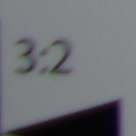 |  | 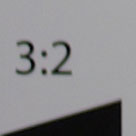 | 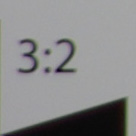 | |||
DA 18-55mm at 18mm f3.5 |
DA 18-55mm at 55mm f3.5 not available |
DA 40mm at f2.8 |
DA 70mm at f2.4 | |||
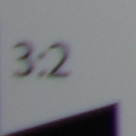 |  | 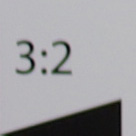 | 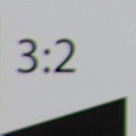 | |||
DA 18-55mm at 18mm f4 |
DA 18-55mm at 55mm f4 not available |
DA 40mm at f4 |
DA 70mm at f4 | |||
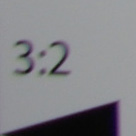 | 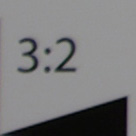 | 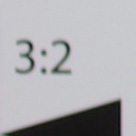 | 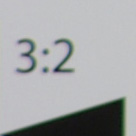 | |||
DA 18-55mm at 18mm f5.6 |
DA 18-55mm at 55mm f5.6 |
DA 40mm at f5.6 |
DA 70mm at f5.6 | |||
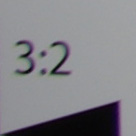 | 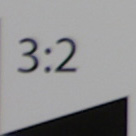 | 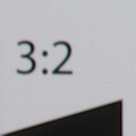 | 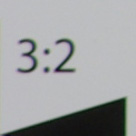 | |||
DA 18-55mm at 18mm f8 |
DA 18-55mm at 55mm f8 |
DA 40mm at f8 |
DA 70mm at f8 | |||
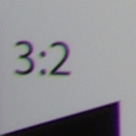 | 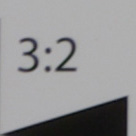 | 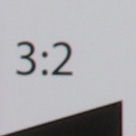 | 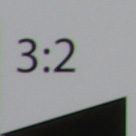 | |||
DA 18-55mm at 18mm f16 |
DA 18-55mm at 55mm f16 |
DA 40mm at f16 |
DA 70mm at f16 | |||
Pentax DA 40 and 70mm lens purple fringing comparison
Pentax DA 40 and 70mm lens results continued…

Outdoor / Resolution / Corner sharpness / Fringe and macro / Geometry / Vignetting
, tested with Pentax K10D |
|
To measure and compare purple fringing on the Pentax lenses, we photographed a test chart with areas of very high contrast. We tested each lens with its aperture wide open using a Pentax K10D in Aperture Priority mode; the DA 18-55mm was tested at both 18 and 55mm. The crops are taken from the upper left corner of the chart and presented here at 100%. The corner crops below look good for both the 40 and 70mm lenses, but upon closer inspection, the 70mm result can exhibit fringing in high contrast areas across the entire frame, and even in the middle. You can see an example of this in our Gallery. |
| |||||||||||||||||||||
Pentax DA 40 and 70mm lens macro comparison, tested with Pentax K10D
|
To measure macro performance we photographed a chart using settings which delivered the maximum possible reproduction. The dark lines are 10mm apart. Each lens was tested with the Pentax K10D at f8 in Aperture Priority mode. The DA 18-55mm kit lens easily delivers the best result here, zoomed-into its longest 55mm focal length. The two Limited edition fixed focal length lenses are clearly not designed for high reproductions at close range, at least not without additional equipment. |
Pentax DA 18-55mm f3.5-5.6 AL at 55mm |
Pentax DA 40mm f2.8 Limited |
Pentax DA 70mm f2.4 Limited | ||
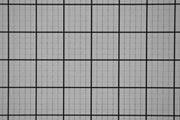 | 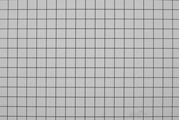 | 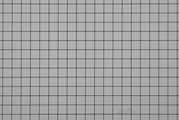 | ||
|
DA 18-55mm at 55mm f8 Max area of 66x44mm |
DA 40mm at f8 Max area of 184x124mm |
DA 70mm at f8 Max area of 194x130mm |
Pentax DA 40 and 70mm lens geometry, tested with Pentax K10D
Pentax DA 40 and 70mm lens results continued…
Outdoor / Resolution / Corner sharpness / Fringe and macro / Geometry / Vignetting
| Support this site by shopping via these links |
To measure geometric distortion we photographed a test chart consisting of a grid pattern with perfectly straight lines. The lenses were tested with their apertures set to f8 using a Pentax K10D in Aperture Priority mode; the DA 18-55mm was tested at both 18 and 55mm focal lengths. The images were analysed with Imatest using 5th Order line calculation and the full areas presented here at a reduced resolution. As you’d hope for higher quality fixed focal length short telephoto lenses, the 40 and 70mm Limited editions exhibit relatively low geometric distortion. Interestingly the 40mm exhibits slight barrelling, whereas the 70mm exhibits the more usual pincushion distortion associated with this kind of focal length. The 70mm suffers from the least distortion here. |
Pentax DA 18-55mm f3.5-5.6 AL |
Pentax DA 40mm f2.8 Limited |
Pentax DA 70mm f2.4 Limited | ||||
 |  |  |  | |||
DA 18-55mm at 18mm f8 Distortion: 2.76% barrel |
DA 18-55mm at 55mm f8 Distortion: 0.58% pincushion |
DA 40mm at f8 Distortion: 0.71% barrel |
DA 70mm at f8 Distortion: 0.42% pincushion | |||
Pentax DA 40 and 70mm lens uniformity, tested with Pentax K10D
Pentax DA 40 and 70mm lens results
Outdoor / Resolution / Corner sharpness / Fringe and macro / Geometry / Vignetting
| Support this site by shopping via these links |
To measure lens vignetting and light fall-off we photographed a white target with a highly diffused filter. The lenses were tested with their apertures wide open using a Pentax K10D in Aperture Priority mode; the DA 18-55mm was tested at both 18 and 55mm focal lengths. The images were analysed with Imatest and the full areas presented here at a reduced resolution. Bigger percentages are better. Using the Pentax 40 and 70mm lenses with their apertures wide open sees the light fall-off in the corners to 70.2 and 73.2% of the centre measurement respectively. These are good results considering their maximum apertures, but nothing remarkable. It’s interesting to note the kit lens zoomed-into 55mm delivers less light fall-off, albeit with a far less impressive maximum aperture. |
Pentax DA 18-55mm f3.5-5.6 AL |
Pentax DA 40mm f2.8 Limited |
Pentax DA 70mm f2.4 Limited | ||||
 |  |  |  | |||
DA 18-55mm at 18mm f3.5 Mean corner fall-off: 61.8% |
DA 18-55mm at 55mm f5.6 Mean corner fall-off: 81.1% |
DA 40mm at f2.8 Mean corner fall-off: 70.2% |
DA 70mm at f2.4 Mean corner fall-off: 73.2% | |||
